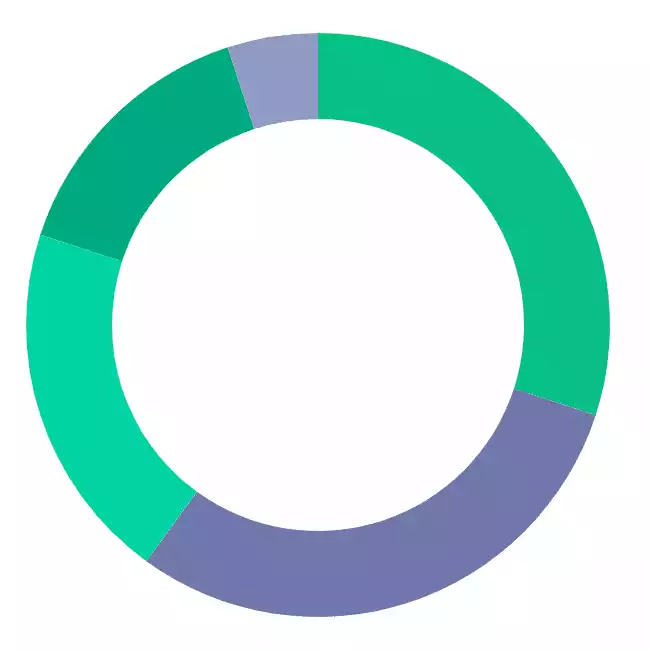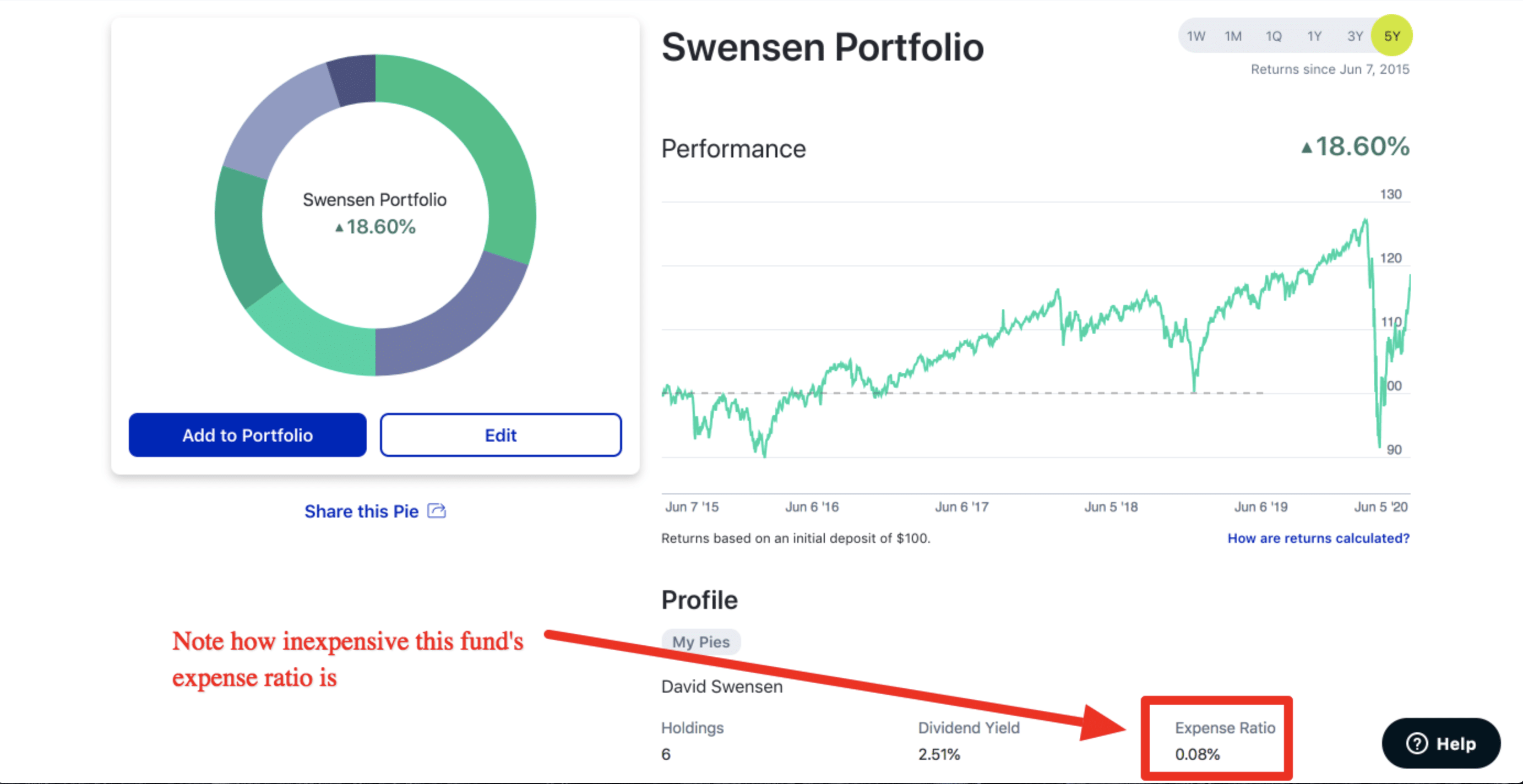Figuring out the perfect investment strategy can be tough, especially if you go it alone. You have to worry about asset allocation, which assets to focus on, and other countless details. It’s a lot to handle. Luckily, there are some ready-made portfolios out there.
Today we’re going to talk about the Swensen Portfolio. What it is, how you can replicate it, and whether it’s right for you.
What Is the Swensen Portfolio
David Swensen is the President and Chief Investment Officer of Yale University endowment. Swensen, along with Dean Takahashi, invented The Yale Model.
He then wrote a book called Unconventional Success detailing how individual investors can mirror The Yale Model in their portfolios.
The final product is what’s known as the Swensen Portfolio.
He attempts to diversify it with an asset allocation combining the total stock market, international stocks, emerging markets, intermediate bonds, and real estate in the form of REITs.
Although Swensen invented both, the Swensen Portfolio is not to be confused with the Yale Portfolio this is a portfolio inspired by Yale endowment model.
The Yale Portfolio invests in exotics only available to institutional investors, putting it out of reach for most. But you can model the David Swensen Portfolio.
The Swensen Portfolio Asset Allocation
The below represent the weightings, core components, and asset classes involved when building this model.
| Weighting | Portfolio Components | Asset Class |
|---|---|---|
| 30% | Total Stock Market | Stock |
| 15% | International Stock Market | Stock |
| 5% | Emerging Markets | Stock |
| 15% | TIPS | Intermediate Bond |
| 15% | U.S. Treasuries | Intermediate Bond |
| 20% | REITs | Real Estate |
Note: Some Swensen Portfolio models show an asset allocation of 15% REITs and 10% emerging markets.
A contrarian investment approach that promotes a well-diversified, equity-oriented portfolio that rewards investors who exhibit the courage to stay the course. Swensen, creator of this portfolio is the mastermind behind the Yale Endowment investment strategy.
The Swensen Portfolio divides the bulk of its asset allocation between US stocks and Intermediate bonds. Within bonds, he splits it evenly at 15% between TIPS (Treasury Inflation-protected securities) and US Treasury Bonds.
Instead of investing directly in brick and mortar real estate, the Swensen Portfolio advises 20% to be put into REITs (Real Estate Investment Trusts).
International stocks make up a slightly smaller asset allocation at 15% of the total fund with emerging markets having a smaller slice at 5%.
U.S. Stocks
David Swensen believes in investing in market-cap-weighted US equities. With a nearly 10% rate of return since 1900, having a large portion of your portfolio in US stocks isn’t controversial.
What’s controversial is having only 30% of your asset allocation towards US stocks.
While 100% stocks, such as with the Vanguard VTSAX index fund will have the highest rate of return in a bull market, Swensen believes his model will perform better over the long run without the gut-wrenching drops of an all-stock portfolio.
Treasury Bonds
Swensen doesn’t treat bonds equally. He’s specifically interested in US Treasury bonds. He believes corporate bonds don’t offer high enough annual returns for the increased risk.
To hedge against inflation, Swensen prefers 15% of the total Swensen Portfolio to be in TIPs while 15% is in US Treasury bonds.
The bond allocation itself is split evenly between US Treasury bonds and TIPs. The idea behind TIPs is they tend to increase in value when inflation rises.
These limit risk by performing well during times of significant equity drawdowns as well as during times of high inflation.
REITs
Real Estate Investment Trusts (REITs) are comprised of companies that own income-producing real estate assets.
If owning a single piece of real estate is like owning stock from a single company, REITs are like owning a mutual fund. They help with the diversification of your portfolio while still generating decent returns.
Since the 1970s, REITs have averaged nearly an 11% return. Like TIPs, real estate increases when inflation rises so they also do well as a hedge.
International Stocks
The Swensen model advocates for investing outside of US stocks in international developed equities. ‘Developed’ refers to being in a similar economic development to the US.
Japan and Western Europe are examples of this.
Since the mid-1970s, this asset class has returned around 9%. He’s not advocating for risky international investments with huge up or downside.
The Swensen Portfolio favors stable, well-known international stocks as investment options (that happen to be outside the US).
The reason international stocks are an essential slice of the Swensen Portfolio pie is they don’t always follow the ups and downs of the US stock market.
Markets often drop because of global situations, but occasionally, the US market falls because of conditions only affecting the US economy.
This asset class takes up 15% of the Swensen Portfolio.
Emerging Markets
Swensen isn’t totally against risk. He advocates for putting 5% of your portfolio into emerging markets.
Emerging markets are economies that are starting to enter the world stage. China is probably the best example of an emerging market.
Within emerging markets, you’ll want to diversify and not put all your eggs in one basket. Emerging market funds invest in entire regions as opposed to single countries.
At only a 5% asset allocation, even if you don’t strike gold you won’t sink your portfolio.
Get our best strategies, tools, and support sent straight to your inbox.
Swensen Portfolio Investment Strategy
The Swensen Portfolio’s overall investment strategy is limiting risk by diversifying between asset classes that do well in opposing times.
During a bull market, US and international stocks will do well. During a bear market, treasury bonds and TIPs will likely outperform (along with the bond market as a whole).
You’ll have REITs and TIPs to protect against inflation. Five percent in emerging markets is the icing on the cake.
Hopefully, you catch a wave and make a strong return with minimal risk to your overall portfolio.
The other piece of the Swensen Portfolio puzzle is the ability of ordinary investors to replicate it.
Every asset class in the Swensen Portfolio is available through low-cost ETF and mutual fund vehicles for anyone to copy. With the Yale Model Portfolio, you have to be an institutional investor or a large university endowment to gain access.
The Swensen Portfolio is the easiest way for individual investors to copy the world-famous Yale Model.
Tweet ThisSwensen Portfolio Returns
While it’s impossible to get an exact rate of return for the Swensen Portfolio (since your asset allocation within the funds varies), the Yale Model has produced around 16% for the past two decades.
It’s unrealistic to expect the same returns produced by Yale’s endowment portfolio. The Swensen Portfolio is one of the most copied investment models in the world.
If everyone could achieve 16% annual returns year over year, nobody would bother investing any other way.
Still, the Swensen model is nearly dummy-proof and an excellent way for the lazy investor to limit risk while maximizing returns.
Potential Risks of the Swensen Portfolio
The main risk is losing out on the massive returns of an all-stock portfolio. For example, 100% invested in VTSAX. During boom times, you’ll most likely earn more money.
The Swensen Portfolio is well diversified; you shouldn’t have those gut-wrenching drops investors feel with a 100% stock portfolio.
Because you can purchase all of these asset classes through ETFs or mutual funds, your expense ratio will be small.
Replicating the Swensen Portfolio with M1 Finance
M1 Finance is a
M1 Finance sticks out among Robo-advisors by offering pre-made funds mirroring the strategies of top investors.
A contrarian investment approach that promotes a well-diversified, equity-oriented portfolio that rewards investors who exhibit the courage to stay the course. Swensen, creator of this portfolio is the mastermind behind the Yale Endowment investment strategy.
It makes copying their models even easier as you don’t have to fit the pieces together.
In addition to replicating the Swensen Portfolio, M1 Finance is a great choice for individual investors because they have zero transaction fees and make regular rebalancing seamless.
If you like the idea of an all-inclusive portfolio but prefer an alternative asset allocation to the Swensen model, the Larry portfolio, All-Weather portfolio, and Golden Butterfly portfolio are great substitutes.
Is the Swensen Portfolio Model Right for You?
The Swensen Portfolio is an attractive alternative if you’re looking to diversify further than a traditional 60/40 stock/bond mix.
While it’s a popular model, it isn’t the only show in town. The Larry Portfolio (LP) has become fashionable for those looking to limit their potential downside even further.
The LP favors a bond allocation of 70% while using small-cap stocks to increase its upside.
The Swensen Portfolio asset allocation holds more equities than the Larry Portfolio and prefers to limit risk by focusing on more mid-cap and large-cap stocks.
For those who would rather not live through enormous drops, the Swensen Portfolio model consistently generates excellent returns (without the colossal downside potential of a 100% stock portfolio).
If all of this seems too much to think about you can always invest 100% in low-cost index funds. However, be ready to endure a few massive dips along the way.





